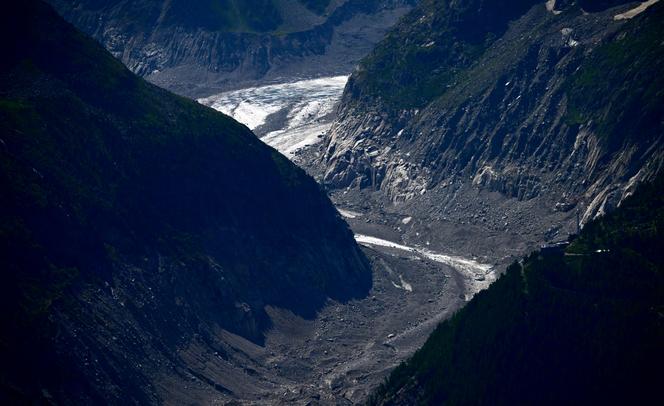


Every summer for the past 15 years, glaciologist Luc Moreau has been telling the story of the iconic Mer de Glace, located in the Mont-Blanc massif, to the 3,000 or so tourists who come every day to see the largest glacier in the French Alps. But every year, he is increasingly affected by the sight of the glacier's long, dark trail. "It's nothing more than a pile of rocks, a battlefield," he deplored. "The worst thing is that we are the cause of this disappearance."
The Alps are among the glacier regions most affected by human-induced climate change. The decline of these famous mountains has accelerated dramatically in recent years: They have lost a third of their ice volume in just 20 years. On average, the glaciers have retreated by an 30 meters a year over this period, thinning by one to 1.5 meters across their entire surface every year.
The figures for the Mer de Glace are just as staggering: It has retreated by 1 kilometer in 35 years (11 kilometers remain) and lost 160 meters in thickness. The retreat is such that the Compagnie du Mont-Blanc had to set up a new cable car in February to reach the increasingly distant glacier. However, it's still necessary to descend 150 steps to reach the glacier, and "more will have to be added every year," warned Moreau.
By 2022, the decline of the white giants had reached alarming levels, with the highest glaciers even undergoing thinning. "This had never been seen before. They lost more than 3 meters in thickness between 4,000 and 4,300 meters above sea level, that is, more in one year than in the hundred years between 1905 and 2005," explained Christian Vincent, research engineer at Grenoble's Institute for Environmental Geosciences (IGE). Unfortunately, the year 2023 was "quite typical, with largely negative mass balances," added the scientist. There was much more ice melt downstream than snow accumulation upstream.
This year may offer a small respite for the glaciers – or at least be less severe than in previous years – but it's still too early to confirm this. Due to heavy winter and spring precipitation, peaks above 2,500 meters accumulated a significant amount of snow. However, the hot weather at the end of July accelerated the melting process. The fate of the glaciers will now depend largely on temperatures in August, September and perhaps October.
No matter what, the future remains bleak. Glaciers in the Alps are set to lose at least a third of their volume between 2022 and 2050, whatever measures are taken, due to the inertia of the climate system. "This is the most optimistic scenario, assuming that global warming stops today," explained Antoine Rabatel, glaciologist at the IGE and one of the authors of the research published in December 2023. This scenario is not realistic, however, as global greenhouse gas emissions continue to rise.
You have 53.07% of this article left to read. The rest is for subscribers only.
